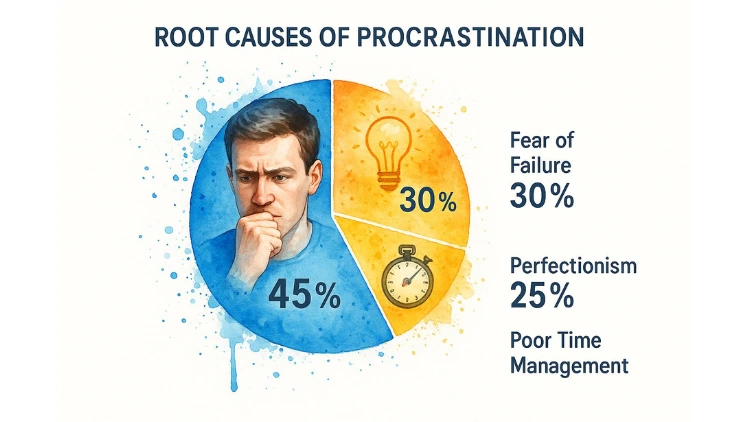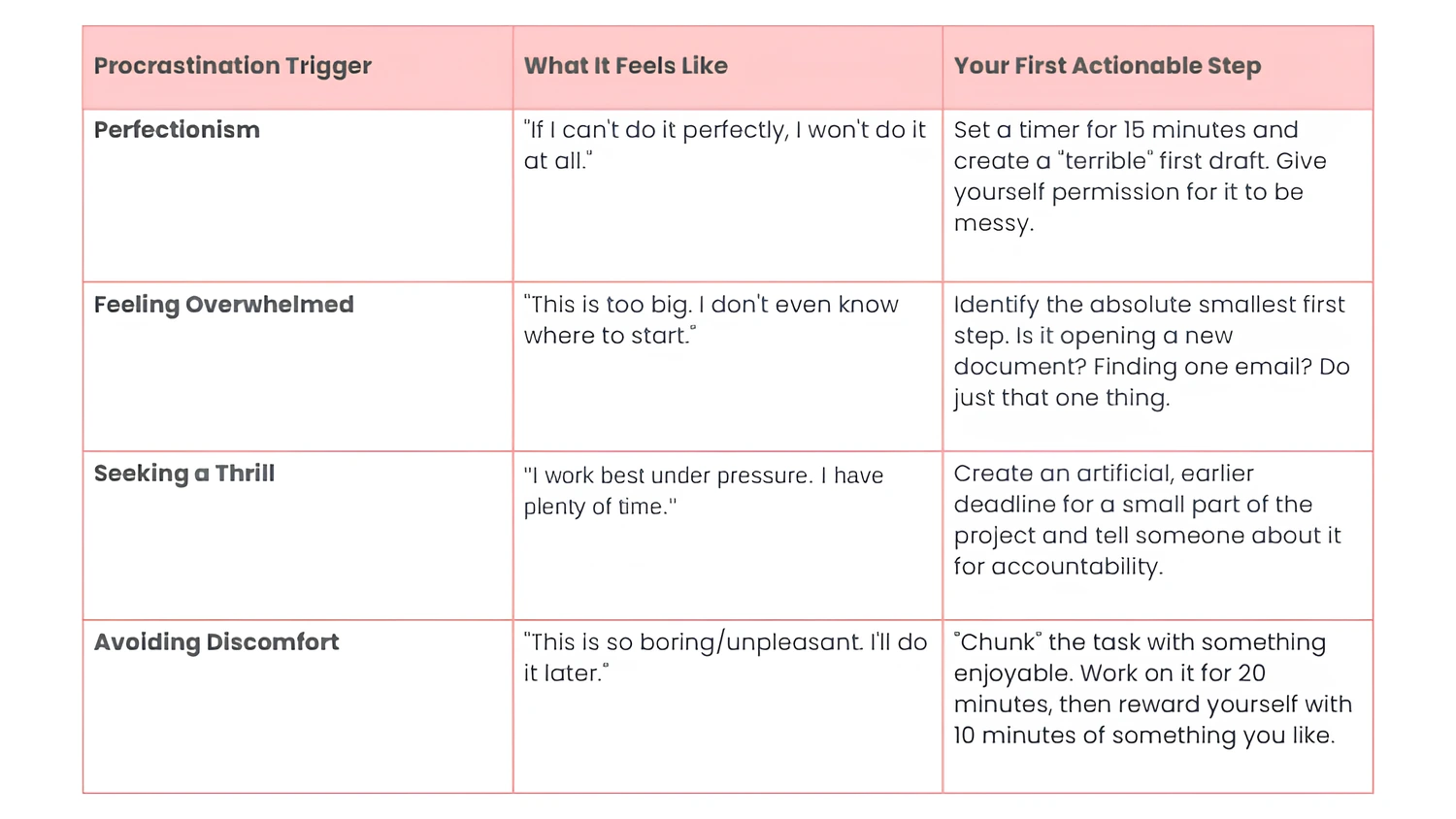How to Overcome Procrastination: Tips to Boost Productivity

If you've ever beaten yourself up for procrastinating, I want you to stop right there. The common advice to "just manage your time better" completely misses the point. Overcoming procrastination isn't about willpower or fancy planners; it's about getting to the bottom of what's really going on emotionally.
The real key is to pinpoint your triggers—like a paralyzing fear of failure or crippling perfectionism—and then use small, manageable actions to break that painful cycle of delay. This is a game of strategy, not brute force.
Jump To Section

Earn As You Learn
Earn 25% commission when your network purchase Uplyrn courses or subscribe to our annual membership. It’s the best thing ever. Next to learning,
of course.
The Real Reasons You Procrastinate
Most of us were taught that procrastination is just a synonym for laziness. It's a convenient, but completely wrong, explanation. At its core, procrastination is an emotional regulation problem. It’s a gut reaction.
When we're faced with a task that dredges up negative feelings—anxiety about a big project, boredom with tedious paperwork, or self-doubt about our abilities—our brain’s immediate impulse is to avoid that discomfort. Delaying the task gives us a fleeting sense of relief. For example, you choose to scroll social media for an hour instead of starting a daunting report. That instant distraction feels better than the anxiety of facing a blank page.
And if you think you're alone in this, you're not. Far from it. Studies show that up to 25% of adults are chronic procrastinators. Some people waste nearly 55 days every single year just putting things off. These numbers aren't meant to shame you; they're meant to show you this is a deeply human experience, not some personal failing.
Common Psychological Triggers
Getting a handle on procrastination means you have to play detective and figure out why you're doing it. The reason is rarely "because I didn't feel like it." It usually runs much deeper. Here are a few of the biggest culprits I see time and time again:
- Fear of Failure: This is a big one. It's that paralyzing thought that your work just won't be good enough. You put off starting that crucial report because you're terrified of the criticism it might receive. The flawed logic is simple: if you never finish it, you can't officially fail. Digging into what fear has to do with time management can be a total game-changer.
- Perfectionism: Ah, the perfectionist. The need for a flawless, pristine outcome can make even starting a task feel completely overwhelming. I've known people who will delay creating a presentation for weeks because they're waiting for the "perfect" idea to strike. This sets an impossibly high bar that just begs for you to put it off.
- Decision Fatigue: Sometimes, it’s not the task itself but the sheer number of choices involved that shuts us down. Putting off organizing your finances isn't necessarily about laziness; it's about the mental exhaustion of just trying to figure out where to even begin.
Procrastination is not a time management problem; it's an emotion management problem. By addressing the underlying feelings, you can begin to dismantle the habit from its source.
Once you start recognizing these patterns in your own behavior, you gain the power to respond differently. For a deeper dive, exploring proven strategies to overcome procrastination and truly boost your productivity starts right here—by understanding what's happening beneath the surface.

Pinpoint Your Personal Procrastination Archetype
If you really want to stop procrastinating, understanding why you do it is only half the battle. The real breakthrough comes when you figure out how you do it. Not all procrastination is created equal, and once you recognize your specific pattern—your archetype—you can ditch the generic advice and start using strategies that actually work for you.
Think of yourself as a detective investigating your own habits. When you put something off, what’s the feeling behind it? That feeling is your biggest clue. Pinpointing your style helps you tackle the problem in a way that feels natural to your personality. If you want to go even deeper, you can explore different learning styles and even discover more about the 9 types of intelligence for some serious self-awareness.
This image really drives home the emotional triggers that fuel procrastination.
It's clear that the fear of failure is a huge one, hitting nearly half of all procrastinators. Perfectionism isn't far behind. These feelings are powerful, no doubt. But the moment you can name them, you start to take their power away.

What is Your Procrastination Style?
So, which one of these sounds a little too familiar? Finding your match is the key to unlocking the right fix.
- The Perfectionist: You put off starting because you're terrified the final result won't be flawless. For example, you might rewrite the first sentence of a report ten times, convinced it’s not quite right, and never move on to the second. The pressure to be perfect paralyzes you before you even start.
- The Overwhelmed: You stare at a big project and all you see is an unclimbable mountain, not a series of manageable steps. Because you have no idea where to begin, you simply don't. This is classic for tasks like “plan the entire family vacation” or “declutter the whole house.”
- The Thrill-Seeker: Let’s be honest—you get a rush from racing against a deadline. You tell yourself you work better under pressure, but this high-stakes game usually just leads to frantic stress, sloppy mistakes, and work that’s just good enough.
- The Avoider: You will do literally anything to sidestep a task that’s boring, unpleasant, or just plain hard. That's why your taxes, that dentist appointment, or cleaning the kitchen sink keeps getting pushed down the to-do list in favor of something—anything—more interesting.
Use this guide to identify what's really causing your delay and the simple, immediate action you can take to break the cycle.
Your Procrastination Triggers and Actionable First Steps
Identifying your archetype isn’t about sticking a label on yourself; it’s about gaining clarity.
Once you know your go-to move, you can finally choose specific, targeted actions that work with your tendencies, not against them.

How to Break Down Big Tasks Without the Overwhelm
Let's be honest, the single biggest reason we put things off is the sheer size of the task staring back at us from our to-do list.
Seeing something like "complete the quarterly report" doesn't just represent a task; it triggers a mental movie of a massive, multi-hour ordeal. It's instantly draining, and it’s no wonder our brains look for any excuse to do something else. The secret to finally getting started is to stop seeing the mountain and start focusing on the first few stones.
This all begins with a simple but surprisingly powerful technique called the Two-Minute Rule. If a task takes less than two minutes to complete, you do it immediately. No exceptions. Actionable insight: Respond to that simple email now. Put your cup in the dishwasher. Tidy the one pile of papers on your desk. This clears out the mental clutter of small, nagging items that sap your energy before you even get to the important stuff.
Use Task Slicing to Build Momentum
For anything that takes longer than two minutes, you need a different approach. I call it Task Slicing. This is where you deconstruct a large goal into the smallest possible concrete actions. You’re not just breaking it down; you’re slicing it into such tiny, bite-sized pieces that they feel almost effortless.
The goal of breaking down a task isn't just about organization. It's about lowering the emotional barrier to entry. A tiny first step requires almost no motivation to complete.
Let’s walk through a real-world example. Instead of that vague, intimidating goal of "write the report," your new, sliced list would look something like this:
- Open a new document and save it with a title.
- Find three key statistics from the sales data.
- Write one sentence for the introduction.
- Draft the first two paragraphs of the main body.
See the difference? Each item is a small, achievable win.
Completing one gives you a tiny jolt of satisfaction, building the momentum you need to roll right into the next one. This creates a positive feedback loop where action fuels more action. If you really want to get organized, using a dedicated task list template for prioritizing productivity can help you structure this process perfectly.
By shrinking the task, you shrink the resistance. You're no longer facing a monumental project; you're just taking one simple, non-threatening step forward.

Engineer Your Environment to Beat Procrastination
When you're trying to finally get a handle on procrastination, your immediate surroundings can be your greatest ally or your worst enemy. Most people think it all comes down to willpower, but that’s a resource that runs out. A well-designed environment, on the other hand, works for you automatically, saving you the mental energy it takes to fight off distractions.
The goal is to design your space to make the right actions easy and the distracting ones a real pain.
Even a tiny change can make a massive difference. For example, if you find yourself endlessly scrolling on your phone, don't just rely on self-control to stop. Actionable insight: Before you sit down to work, physically move your phone to another room. Just that simple act of creating distance makes the distraction much less tempting.
Tweak Your Digital and Physical Spaces
In this day and age, your digital environment is just as important—if not more so—than your physical one. An endless sea of notifications, open tabs, and tempting websites can destroy your focus in a heartbeat. Getting these digital triggers under control isn't optional; it's essential.
Here are a few ways to start:
- Block Distracting Websites: Use a browser extension like Freedom or BlockSite to block access to social media or news sites during your work blocks. It removes the temptation entirely, so your brain doesn't even have to fight it.
- Create a Dedicated Workspace: If you can, carve out a specific spot that is only for work. Over time, your brain will start to associate that location with focus, not with kicking back and watching Netflix.
- Declutter Your Desk: It's true what they say: a cluttered desk leads to a cluttered mind. Spend just five minutes clearing your physical space before you start a task. You'll be surprised at how much it minimizes the mental noise.
A powerful strategy I've seen work wonders is temptation bundling. The idea is simple: you pair something you love doing with a task you typically avoid. This little trick can completely reframe how you feel about chores you dread.
Practical example: Allow yourself to listen to your favorite podcast only while you're folding laundry or cleaning the kitchen. Suddenly, the task you've been putting off becomes the gateway to something you genuinely enjoy, making it so much easier to just get started.
For more ideas on managing your surroundings, check out this article on how to cope with at-home distractions and take back your focus.
From Quick Fixes to Sustainable Habits
Let’s be honest: a single, heroic burst of productivity feels great, but it rarely sticks. Real progress in beating procrastination isn’t about that one perfect day. It’s about building a system that works for you day in and day out, turning those last-minute fixes into habits you don't even have to think about.
The name of the game is consistency, not intensity.
One of the most powerful ways to build this consistency is with time blocking. Instead of staring at a vague to-do list, you treat your most important tasks like can’t-miss appointments. You literally schedule them in your calendar. Practical example: Your calendar shouldn't just say "Work on project." It should say "Tuesday, 10 AM - 11:30 AM: Draft project proposal."
This simple shift does something powerful—it removes the mental gymnastics of deciding when to start. The decision is already made. To really make this stick, you’ll need to learn how to overcome common time management problems so you can fiercely protect those blocks of time from interruptions.
Practice Self-Compassion and Celebrate Wins
Building new habits is messy. There will be days you slip up, ignore your calendar, and fall back into old patterns. That's okay. The trick is what you do next.
Beating yourself up just creates a shame spiral that fuels even more procrastination. Instead, try a little self-compassion. Acknowledge the setback without judgment and just gently guide yourself back to your system. That resilience is what separates a temporary fix from a lasting change. You can dive deeper into the power of routine to see how this foundation holds up, even when you have an off day.
And here's the fun part: you have to celebrate your wins. When you stick to a time block or finally tackle that task you've been dreading, reward yourself. I mean a real reward.
Don't just finish one hard thing and immediately jump into the next. Take a five-minute walk outside. Make a cup of tea and enjoy it away from your desk. Give your brain a genuine break.
This small act of celebration creates a positive feedback loop. It teaches your brain that effort leads to a reward, which slowly transforms productivity from a grind into something genuinely satisfying. Actionable insight: At the end of each day, write down one task you completed that you're proud of, no matter how small. This reinforces your progress.
Got Questions? I’ve Got Answers
When you're first trying to get a handle on procrastination, a lot of the same questions tend to pop up. Let's tackle some of the most common ones I hear, because getting these sorted out can clear up a lot of the mental fog.
Is Procrastination Just Me Being Lazy?
Not at all. This is probably the biggest misconception out there, and it’s a harmful one. Procrastination isn't a character flaw or a sign of laziness—it's almost always an emotional regulation issue.
Practical example: You put off filing your taxes not because you're lazy, but because the task fills you with anxiety about making a mistake or facing a large bill. The "laziness" is just a cover for the real emotion: fear. Calling it "laziness" just piles guilt on top of those feelings, which, ironically, makes us want to avoid the task even more.
How Do I Make Myself Do Boring Tasks?
Ah, the boring stuff. We all have it on our list. For these, the trick is to lower the barrier to entry so much that starting doesn't feel like a monumental effort.
Here are a few tactics I've seen work wonders:
- The Pomodoro Technique is your friend: Just tell yourself you'll work for 25 minutes. Anyone can do something for 25 minutes, right? The short, built-in breaks make the whole thing feel way less daunting.
- Try "Temptation Bundling": This is a fun one. Pair that boring task with something you actually enjoy. Need to fold laundry? Do it while listening to your favorite podcast. Answering emails? Put on a great playlist.
- Focus on the "After-Feeling": Instead of dwelling on how dull the task is, shift your focus to how amazing you'll feel once it's checked off your list. That feeling of relief and accomplishment can be a powerful motivator.
The goal isn't to pretend the task is exciting; it's to make getting it done as quick and painless as possible.
Setbacks are a normal part of building new habits. The goal is progress, not perfection. If you find yourself procrastinating, practice self-compassion instead of self-criticism.
What if I Try These Strategies and Still Procrastinate?
First off, take a deep breath. It's going to happen, and it's completely normal. You're trying to rewire years of ingrained habits.
When you slip up, don't beat yourself up—get curious. Ask yourself what really happened. Was the task still too big? Were you tired, hungry, or stressed about something else? More often than not, there's a reason.
Actionable insight: The next time you procrastinate, take two minutes to write down the trigger. Example: "I avoided my workout because I was exhausted after work." Recognizing the pattern is the first step. Next time, you can schedule your workout for the morning or plan a simpler, shorter exercise for days you're tired.
Ready to build a system that conquers procrastination for good? At Uplyrn, we offer courses and coaching to help you develop sustainable habits and unlock your full potential. Start your journey today at Uplyrn.


Leave your thoughts here...
All Comments
Reply